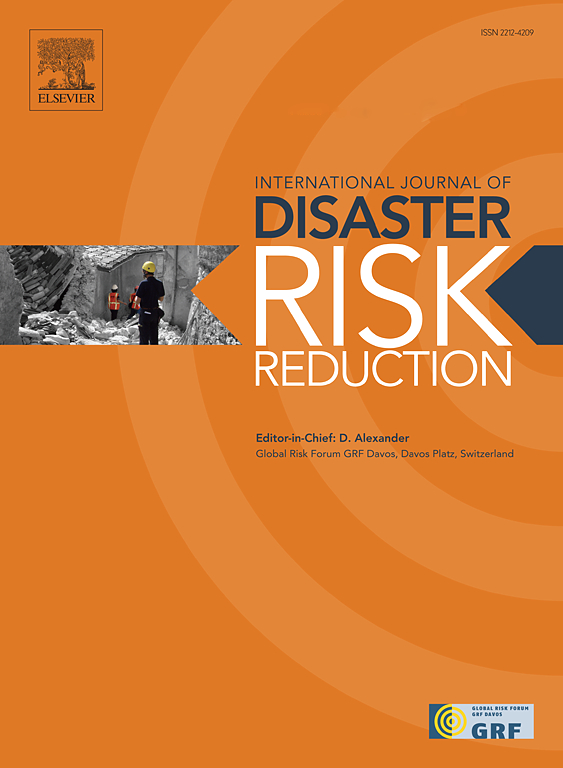Prevalence and predictors of post-traumatic stress disorder among survivors of the 2023 earthquakes in Türkiye: The case of a temporary camp
IF 4.2
1区 地球科学
Q1 GEOSCIENCES, MULTIDISCIPLINARY
International journal of disaster risk reduction
Pub Date : 2024-11-01
DOI:10.1016/j.ijdrr.2024.104976
引用次数: 0
Abstract
This study aimed to evaluate the potential prevalence of post-traumatic stress disorder (PTSD) among survivors of the 2023 Türkiye earthquakes and determine the factors linked to the severity of PTSD. The cross-sectional study was conducted in a temporary camp in Hatay between January 27 and February 2, 2024, approximately one year after the earthquakes. Two researchers visited the camp and offered participation to all the adults who met the study criteria. A total of 412 adults agreed to participate in the study and completed the questionnaire. A survey was used to gather information on various variables related to the context before, during, and after an earthquake. In addition, the Post-Traumatic Diagnostic Scale and the Brief Resilience Scale were used to measure PTSD and resilience, respectively. The screening scale indicated that 17.5 % of participants met the criteria for probable “severe” and 36.2 % met the criteria for probable “moderate to severe” PTSD, approximately 12 months post-earthquake. Multiple linear regression analyses revealed that PTSD was predicted by various factors in the within-, pre-, and post-earthquake periods. Among pre-earthquake variables, sex (β = 0.100, p < 0.05) and history of psychiatric illness (β = 0.098, p < 0.01) predict PTSD. Among within-earthquake variables, severity of earthquake exposure (β = 0.190, p < 0.001) predicted PTSD. Among post-earthquake variables, resilience (β = −0.378, p < 0.001) was negatively associated with severity of PTSD. These findings underscore the significance of considering multiple factors when comprehending and addressing PTSD in the aftermath of a natural disaster.
2023 年土耳其地震幸存者中创伤后应激障碍的患病率和预测因素:临时营地案例
本研究旨在评估 2023 年土耳其地震幸存者中创伤后应激障碍 (PTSD) 的潜在患病率,并确定与创伤后应激障碍严重程度相关的因素。这项横断面研究于 2024 年 1 月 27 日至 2 月 2 日,即地震发生约一年后,在哈塔伊的一个临时营地进行。两名研究人员访问了营地,并向所有符合研究标准的成年人发出了参加研究的邀请。共有 412 名成年人同意参与研究并填写了调查问卷。调查用于收集地震前、地震期间和地震后与环境有关的各种变量的信息。此外,还使用创伤后诊断量表和简易复原力量表分别测量创伤后应激障碍和复原力。筛查量表显示,在震后约 12 个月,17.5% 的参与者符合可能的 "重度 "创伤后应激障碍标准,36.2% 的参与者符合可能的 "中度至重度 "创伤后应激障碍标准。多元线性回归分析表明,创伤后应激障碍可由震中、震前和震后的各种因素预测。在震前变量中,性别(β = 0.100,p < 0.05)和精神病史(β = 0.098,p < 0.01)可预测创伤后应激障碍。在震内变量中,地震暴露的严重程度(β = 0.190,p < 0.001)可预测创伤后应激障碍。在震后变量中,复原力(β = -0.378,p < 0.001)与创伤后应激障碍的严重程度呈负相关。这些发现强调了在理解和解决自然灾害后创伤后应激障碍时考虑多种因素的重要性。
本文章由计算机程序翻译,如有差异,请以英文原文为准。
求助全文
约1分钟内获得全文
求助全文
来源期刊

International journal of disaster risk reduction
GEOSCIENCES, MULTIDISCIPLINARYMETEOROLOGY-METEOROLOGY & ATMOSPHERIC SCIENCES
CiteScore
8.70
自引率
18.00%
发文量
688
审稿时长
79 days
期刊介绍:
The International Journal of Disaster Risk Reduction (IJDRR) is the journal for researchers, policymakers and practitioners across diverse disciplines: earth sciences and their implications; environmental sciences; engineering; urban studies; geography; and the social sciences. IJDRR publishes fundamental and applied research, critical reviews, policy papers and case studies with a particular focus on multi-disciplinary research that aims to reduce the impact of natural, technological, social and intentional disasters. IJDRR stimulates exchange of ideas and knowledge transfer on disaster research, mitigation, adaptation, prevention and risk reduction at all geographical scales: local, national and international.
Key topics:-
-multifaceted disaster and cascading disasters
-the development of disaster risk reduction strategies and techniques
-discussion and development of effective warning and educational systems for risk management at all levels
-disasters associated with climate change
-vulnerability analysis and vulnerability trends
-emerging risks
-resilience against disasters.
The journal particularly encourages papers that approach risk from a multi-disciplinary perspective.
 求助内容:
求助内容: 应助结果提醒方式:
应助结果提醒方式:


